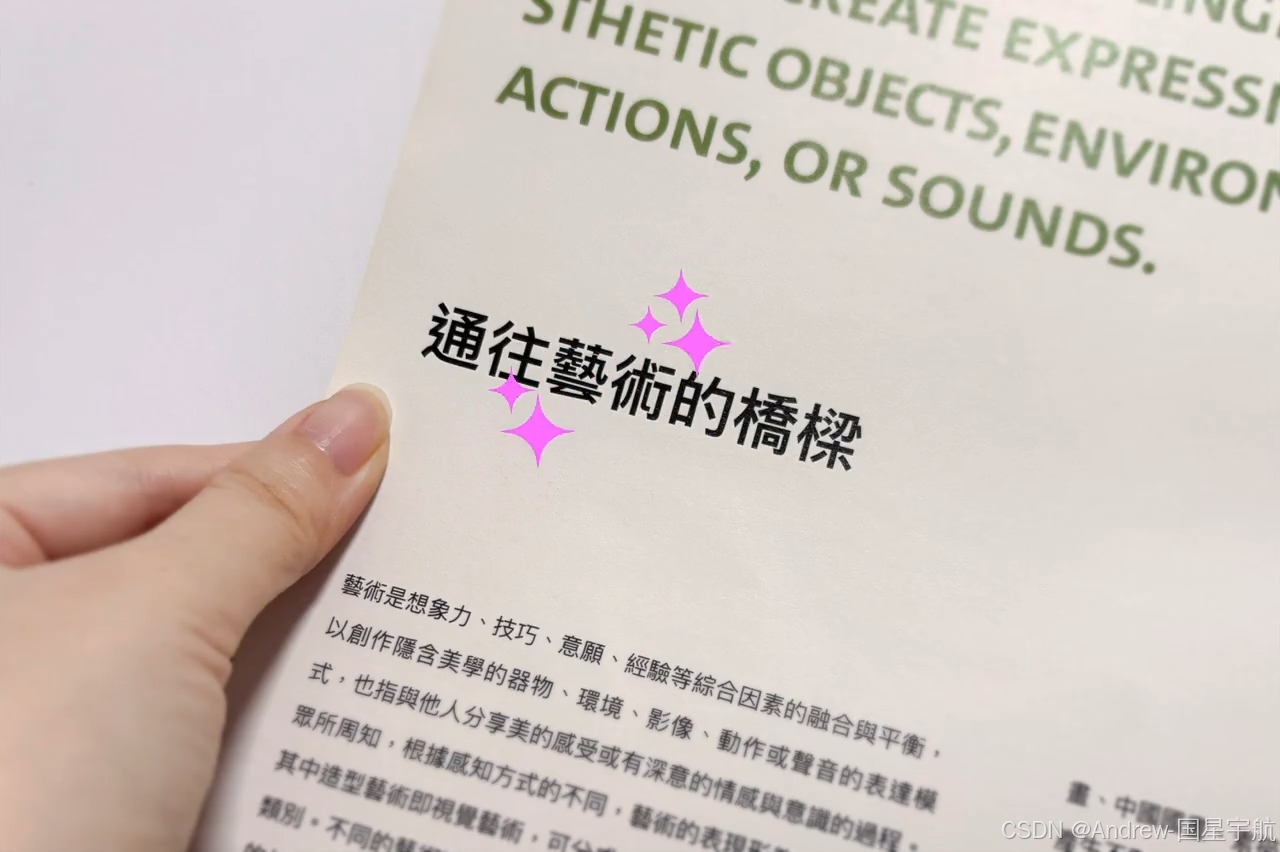
一、引言:大模型重塑图像处理范式
传统图像处理依赖手工设计的特征提取器(如SIFT、HOG)和固定规则的算法组合,在复杂场景(如语义理解、创意生成)中往往力不从心。而以扩散模型、视觉-语言模型为代表的大模型技术,通过海量数据学习到的通用视觉表征,实现了"端到端"的图像处理能力跃迁。
如今,大模型已覆盖图像处理全链路:从文本生成图像的创意创作,到图像修复、超分的质量增强,再到OCR、目标检测的内容理解,甚至支持浏览器端的实时推理。本文将基于Hugging Face生态,通过可复现的代码范例,带你掌握大模型在图像处理中的核心应用。
二、核心技术栈与环境准备
2.1 关键库选型
图像处理大模型生态以PyTorch为基础,核心库包括:
- Diffusers:Hugging Face官方扩散模型库,封装了Stable Diffusion全系列能力
- Transformers:提供多模态模型(如CLIP、Florence-2)的统一调用接口
- ControlNet Aux:ControlNet所需的条件图像生成工具集
- Real-ESRGAN:专注于超分辨率与图像修复的专用模型库
2.2 环境配置
bash
# 创建虚拟环境
conda create -n mmcv python=3.10
conda activate mmcv
# 安装核心依赖
pip install torch torchvision torchaudio --index-url https://download.pytorch.org/whl/cu121
pip install diffusers==0.30.0 transformers==4.41.0 controlnet-aux==0.0.7
pip install pillow requests scipy realesrgan三、实战场景一:文本驱动的图像生成
基于Stable Diffusion 3.5的文本生成图像(Text2Image)是最基础的应用场景,其核心是通过扩散过程在潜空间逐步去噪生成目标图像。
3.1 基础实现:快速生成图像
python
import torch
from diffusers import StableDiffusion3Pipeline
def text2image(prompt: str, output_path: str = "output.png"):
# 加载SD3.5模型,使用bfloat16节省显存
pipeline = StableDiffusion3Pipeline.from_pretrained(
"stabilityai/stable-diffusion-3.5-large-turbo",
torch_dtype=torch.bfloat16,
variant="fp16"
)
# 启用CPU卸载优化,8GB显存可运行
pipeline.enable_model_cpu_offload()
# 进度回调函数
def progress_callback(step, timestep, latents):
print(f"生成进度: {step/4*100:.1f}%") # SD3.5-turbo仅需4步
# 生成图像
image = pipeline(
prompt=prompt,
negative_prompt="模糊, 变形, 低质量, 文本", # 负向提示词排除干扰
num_inference_steps=4,
guidance_scale=7.0,
callback=progress_callback
).images[0]
# 保存结果
image.save(output_path)
return output_path
# 调用示例:生成赛博朋克风格图像
text2image(
prompt="赛博朋克城市夜景,悬浮车在霓虹雨中穿行,玻璃幕墙反射全息广告,风格参考《银翼杀手2049》",
output_path="cyberpunk_city.png"
)3.2 进阶技巧:参数调优与批量生成
- 种子控制 :设置
generator=torch.Generator("cuda").manual_seed(42)保证结果可复现 - 批量生成 :通过
num_images_per_prompt=4一次生成多张图像 - 风格强化 :使用权重标记
(悬浮车:1.5)突出关键元素
四、实战场景二:精准可控的图像编辑
4.1 图像修复(Inpaint)
针对图像破损、移除水印等场景,StableDiffusionInpaintPipeline可实现局部重绘:
python
import PIL
import torch
from diffusers import StableDiffusionInpaintPipeline
def image_inpainting(init_image_path: str, mask_path: str, prompt: str):
# 加载模型
pipe = StableDiffusionInpaintPipeline.from_pretrained(
"runwayml/stable-diffusion-inpainting",
torch_dtype=torch.float16
).to("cuda")
# 加载图像与掩码(白色区域为待修复部分)
init_image = PIL.Image.open(init_image_path).resize((512, 512))
mask_image = PIL.Image.open(mask_path).resize((512, 512))
# 执行修复
result = pipe(
prompt=prompt,
image=init_image,
mask_image=mask_image,
num_inference_steps=20
).images[0]
result.save("inpaint_result.png")
return result
# 调用示例:将图像中的猫替换为狗
image_inpainting(
init_image_path="cat.jpg",
mask_path="cat_mask.png", # 仅猫区域为白色的掩码图
prompt="Face of a yellow dog, high resolution, sitting on a park bench"
)4.2 ControlNet可控生成
ControlNet通过条件图像(如线稿、骨骼图)精准控制生成结构,以下是Canny边缘控制的实现:
python
from PIL import Image
from controlnet_aux import CannyDetector
from diffusers import ControlNetModel, StableDiffusionControlNetPipeline
import torch
def controlnet_canny_demo(input_image_path: str, prompt: str):
# 1. 生成Canny边缘图(条件图像)
canny_detector = CannyDetector()
input_image = Image.open(input_image_path)
condition_image = canny_detector(
input_image,
low_threshold=100,
high_threshold=200
)
# 2. 加载ControlNet与基础模型
controlnet = ControlNetModel.from_pretrained(
"lllyasviel/sd-controlnet-canny",
torch_dtype=torch.float16
)
pipe = StableDiffusionControlNetPipeline.from_pretrained(
"runwayml/stable-diffusion-v1-5",
controlnet=controlnet,
torch_dtype=torch.float16
).to("cuda")
# 3. 生成图像
result = pipe(
prompt=prompt,
image=condition_image,
num_inference_steps=20,
guidance_scale=7.5
).images[0]
# 保存结果(原图+边缘图+生成图)
combined = Image.new("RGB", (input_image.width*3, input_image.height))
combined.paste(input_image, (0, 0))
combined.paste(condition_image, (input_image.width, 0))
combined.paste(result, (input_image.width*2, 0))
combined.save("controlnet_result.png")
return result
# 调用示例:根据线稿生成写实人物
controlnet_canny_demo(
input_image_path="sketch.png",
prompt="portrait of a young woman, realistic skin texture, soft lighting, 8k"
)五、实战场景三:图像内容理解与分析
5.1 CLIP零样本图像分类
CLIP通过对比学习实现了图像与文本的跨模态对齐,支持零样本分类:
python
import clip
import torch
from PIL import Image
def clip_image_classification(image_path: str, candidate_labels: list):
# 加载模型(ViT-B/32平衡速度与精度)
device = "cuda" if torch.cuda.is_available() else "cpu"
model, preprocess = clip.load("ViT-B/32", device=device)
# 预处理图像与文本
image = preprocess(Image.open(image_path)).unsqueeze(0).to(device)
text = clip.tokenize([f"a photo of a {label}" for label in candidate_labels]).to(device)
# 推理计算相似度
with torch.no_grad():
image_features = model.encode_image(image)
text_features = model.encode_text(text)
# 归一化并计算概率
image_features /= image_features.norm(dim=-1, keepdim=True)
text_features /= text_features.norm(dim=-1, keepdim=True)
probs = (100.0 * image_features @ text_features.T).softmax(dim=-1)
# 输出结果
results = [(candidate_labels[i], float(probs[0][i])) for i in range(len(candidate_labels))]
results.sort(key=lambda x: x[1], reverse=True)
print("分类结果:", results)
return results
# 调用示例:识别街道场景中的物体
clip_image_classification(
image_path="street.jpg",
candidate_labels=["cat", "dog", "bicycle", "tree", "building", "street"]
)5.2 Florence-2多任务理解
微软Florence-2支持OCR、目标检测等10+视觉任务,是多模态理解的利器:
python
import requests
from PIL import Image
from transformers import AutoProcessor, AutoModelForCausalLM
import torch
def florence2_multitask(image_url: str, task_prompt: str):
# 设备配置
device = "cuda" if torch.cuda.is_available() else "cpu"
dtype = torch.bfloat16 if torch.cuda.is_available() else torch.float32
# 加载模型与处理器
model = AutoModelForCausalLM.from_pretrained(
"microsoft/Florence-2-base",
torch_dtype=dtype,
trust_remote_code=True
).to(device)
processor = AutoProcessor.from_pretrained(
"microsoft/Florence-2-base",
trust_remote_code=True
)
# 加载图像
image = Image.open(requests.get(image_url, stream=True).raw).convert("RGB")
# 预处理与推理
inputs = processor(
text=task_prompt,
images=image,
return_tensors="pt",
padding=True
).to(device, dtype)
generated_ids = model.generate(
**inputs,
max_new_tokens=1024,
num_beams=3 # 束搜索提升生成质量
)
# 后处理结果
result = processor.batch_decode(
generated_ids,
skip_special_tokens=True
)[0]
print(f"任务结果 ({task_prompt}):", result)
return result
# 调用示例1:图像描述
florence2_multitask(
image_url="https://picsum.photos/id/237/512/512",
task_prompt="<MORE_DETAILED_CAPTION>"
)
# 调用示例2:OCR识别
florence2_multitask(
image_url="https://picsum.photos/id/1076/512/512", # 含文字的图像
task_prompt="<OCR>"
)六、实战场景四:图像质量增强
6.1 Real-ESRGAN超分辨率
针对低清图像的质量提升,Real-ESRGAN在动漫与写实场景均有优异表现:
python
import os
from basicsr.archs.rrdbnet_arch import RRDBNet
from realesrgan import RealESRGANer
from realesrgan.archs.srvgg_arch import SRVGGNetCompact
from PIL import Image
def realesrgan_superres(image_path: str, output_path: str, model_name: str = "RealESRGAN_x4plus_anime_6B"):
# 模型配置(动漫专用6B模型)
if model_name == "RealESRGAN_x4plus_anime_6B":
model = RRDBNet(
num_in_ch=3, num_out_ch=3, num_feat=64,
num_block=6, num_grow_ch=32, scale=4
)
model_path = "weights/RealESRGAN_x4plus_anime_6B.pth"
else: # 通用模型
model = SRVGGNetCompact(num_in_ch=3, num_out_ch=3, num_feat=64, num_conv=16, upscale=4, act_type='prelu')
model_path = "weights/realesr-general-x4v3.pth"
# 初始化超分器
upsampler = RealESRGANer(
scale=4,
model_path=model_path,
model=model,
tile=0,
tile_pad=10,
pre_pad=0,
half=True if torch.cuda.is_available() else False,
device="cuda" if torch.cuda.is_available() else "cpu"
)
# 处理图像
image = Image.open(image_path).convert("RGB")
image_tensor = torch.from_numpy(np.array(image)).permute(2, 0, 1).float() / 255.0
image_tensor = image_tensor.unsqueeze(0).to("cuda")
output, _ = upsampler.enhance(image_tensor, outscale=4)
# 保存结果
output_image = Image.fromarray(
np.clip(output[0].permute(1, 2, 0).cpu().numpy() * 255, 0, 255).astype(np.uint8)
)
output_image.save(output_path)
return output_image
# 调用示例:动漫图像4倍超分
realesrgan_superres(
image_path="lowres_anime.png",
output_path="highres_anime.png",
model_name="RealESRGAN_x4plus_anime_6B"
)七、性能优化与工程化实践
7.1 显存优化策略
- 混合精度计算 :使用
torch.bfloat16或torch.float16减少50%显存占用 - 模型卸载 :
pipeline.enable_model_cpu_offload()实现模型在CPU/GPU间动态调度 - 梯度禁用 :推理时使用
torch.no_grad()避免计算图存储
7.2 分布式推理加速
对于大模型(如SD3.5 Large),可通过vLLM实现多GPU并行推理:
python
from vllm import LLM
from diffusers import StableDiffusion3Pipeline
# 多GPU张量并行(4卡配置)
llm = LLM(
model="stabilityai/stable-diffusion-3.5-large",
tensor_parallel_size=4,
dtype="bfloat16"
)
# 结合Diffusers管道使用
pipeline = StableDiffusion3Pipeline.from_pretrained(
"stabilityai/stable-diffusion-3.5-large",
llm=llm,
torch_dtype=torch.bfloat16
)7.3 提示词工程最佳实践
采用"主体-环境-风格"三层结构:
主体:(机械蝴蝶:1.2) 停在复古电话亭上
环境:雨后黄昏,石板路反光,远处有电车驶过
风格:宫崎骏动画风格,细腻线条,柔和光影
负向:模糊,变形,低细节,文字,水印八、总结与展望
大模型已将图像处理从"算法拼接"推向"模型驱动"的新时代,其核心优势在于:
- 跨模态理解:实现文本、图像的深度语义对齐
- 可控性提升:ControlNet、LoRA等技术实现精准控制
- 低代码门槛:Diffusers等库封装了复杂流程
未来,随着Stable Diffusion 4.0、Florence-3等模型的推出,以及3D视觉、实时视频处理能力的突破,大模型将在工业设计、影视制作、自动驾驶等领域释放更大价值。建议开发者关注Hugging Face模型库与Stability AI的技术动态,持续跟进最新进展。